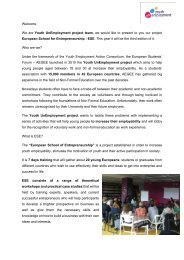A YOUTH GUARANTEE FOR EUROPE - Projects
A YOUTH GUARANTEE FOR EUROPE - Projects
A YOUTH GUARANTEE FOR EUROPE - Projects
You also want an ePaper? Increase the reach of your titles
YUMPU automatically turns print PDFs into web optimized ePapers that Google loves.
A <strong>YOUTH</strong><br />
<strong>GUARANTEE</strong><br />
<strong>FOR</strong> <strong>EUROPE</strong><br />
Towards a rights-based<br />
approach to youth<br />
employment policy
Editorial team<br />
Editor in Chief — Giuseppe Porcaro<br />
Author — James Higgins<br />
Copy Editor — Thomas Spragg<br />
Graphic Design — Laurent Doucet<br />
European Youth Forum<br />
120, rue Joseph II<br />
1000, Bruxelles<br />
Belgium – Belgique<br />
with the support of :<br />
the European Commission<br />
the European Youth Foundation of the Council of Europe<br />
ISSN : 2032–9938<br />
2012 European Youth Forum
Contents<br />
1. Introduction<br />
5<br />
2. Youth Unemployment: No Easy Way Out<br />
6<br />
3. Youth on the Move (Towards a Youth Guarantee)<br />
9<br />
4. Current Youth Guarantees in Europe<br />
11<br />
5. The Youth Guarantee Cookbook<br />
14<br />
6. Conclusion<br />
17
1. INTRODUCTION<br />
The concept of a “youth guarantee”, also<br />
known as a “job guarantee” in some countries,<br />
is one where governments, regional<br />
authorities and public employment services<br />
commit to offering a young person a job,<br />
training or re-training within a certain period<br />
of being made unemployed or leaving<br />
formal education.<br />
The core principle behind the youth guarantee<br />
is ensuring equality of opportunity<br />
for young people in the labour market.<br />
Early labour market activation measures,<br />
such as the youth guarantee, are being increasingly<br />
called for in response to growing<br />
levels of youth unemployment, which pose<br />
a real threat to the European social model<br />
and the ability of Europe to recover from<br />
the recent financial crisis.<br />
Research has increasingly shown that the<br />
current youth unemployment situation<br />
could have economic and social consequences<br />
for the next decade and that it<br />
is putting the physical and mental health<br />
of an entire generation of young people at<br />
risk.<br />
In order for the youth guarantee to be implemented<br />
fully and for the European institutions<br />
and Member States to make a real<br />
investment in youth employability, we must<br />
first understand the gravity of the situation,<br />
the potential of the youth guarantee<br />
to address youth unemployment and previous<br />
best practices of the implementation<br />
of a youth guarantee and a rights-based<br />
approach to youth employment.<br />
All statistics in this publication are as of<br />
July 2012, unless otherwise stated.<br />
1. Introduction<br />
5
2. <strong>YOUTH</strong><br />
UNEMPLOYMENT:<br />
NO EASY WAY OUT<br />
2. Youth Unemployment: No Easy Way Out<br />
UNDER 25s UNEMPLOYED IN THE EU<br />
22.6 %<br />
6
Youth unemployment has been consistently<br />
higher that that of the adult population<br />
over the past number of decades. 1 There<br />
are a number of reasons for this, but one<br />
of the most significant is that often young<br />
people lack the skills in order to easily find<br />
a job. Those that do find work often find<br />
themselves victims of a “last in, first out”<br />
policy that makes new labour market entrants<br />
much more vulnerable.<br />
The increasing deregulation of the labour<br />
market of the past 20 years has made the<br />
transition from education to full-time employment<br />
even more difficult. Even when<br />
young people do manage to find a job<br />
they are often stuck in a cycle of temporary<br />
contracts and poorly paid work. This<br />
intrinsic lack of stability in the labour market<br />
has resulted in the rapid spiralling of<br />
youth unemployment since the onset of<br />
the economic crisis. According to latest figures<br />
released by the International Labour<br />
Organization (ILO), youth unemployment<br />
in the EU and other developed countries<br />
soared 26.5% from 2008 to 2011, the<br />
steepest increase from all the world regions<br />
ranked by the ILO. 2<br />
We now face a situation in Europe where<br />
countries such as Spain and Greece have<br />
a youth unemployment rate of over 50%<br />
and in Bulgaria, Ireland, Italy, Lithuania,<br />
Portugal and Slovakia, youth unemployment<br />
exceeds 30%. 3<br />
2. Youth Unemployment: No Easy Way Out<br />
1. http://epp.eurostat.ec.europa.eu/statistics_explained/index.php?title=File:Unemployment_rate_by_gender_and_age,_2006-2011_%28%25%29.png<br />
&filetimestamp=20120502101521<br />
2. International Labour Office, Global Employment Trends for Youth (Geneva 2012)<br />
3. http://epp.eurostat.ec.europa.eu/statistics_explained/index.php/Unemployment_statistics<br />
7
TOP <strong>YOUTH</strong> UNEMPLOYMENT<br />
RATES IN EU COUNTRIES<br />
GREECE<br />
2. Youth Unemployment: No Easy Way Out<br />
SPAIN<br />
PORTUGAL<br />
ITALY<br />
54.3 %<br />
52.4 %<br />
37.4 %<br />
34.2 %<br />
The longer this situation continues the<br />
more difficult it will become to rectify.<br />
Recent research has shown that long periods<br />
of unemployment for young people<br />
have potential “scarring” effects which<br />
have a harmful impact in later life, particularly<br />
for young people not in employment,<br />
education or training. It can lower future income<br />
levels, skills validity, future employability,<br />
job satisfaction, happiness, and<br />
health levels. Estimations that a six month<br />
spell of unemployment at the age of 22<br />
would result in an 8% lower wage at 23,<br />
and even at ages 30 and 31 wages would<br />
be 2-3% lower than they would have been<br />
otherwise highlight that the mass youth unemployment<br />
levels like the ones we are currently<br />
facing could affect European society<br />
for decades to come. 4<br />
NEET YOUNG PEOPLE<br />
12.8 %<br />
NOT IN:<br />
EDUCATION,<br />
EMPLOYMENT,<br />
OR TRAINING<br />
4. Bell, D., Blanchflower, D., Youth Unemployment: Déjà Vu? (University of Sterling, 2009)<br />
8
3. <strong>YOUTH</strong> ON THE MOVE<br />
(TOWARDS A <strong>YOUTH</strong><br />
<strong>GUARANTEE</strong>)<br />
The European Youth Forum and youth organisations<br />
have been highlighting for<br />
years that unemployment when young not<br />
only hinders personal development and<br />
lowers life chances, exposing youth to poverty<br />
and social exclusion, but also prevents<br />
young Europeans from contributing to the<br />
overall development of their local community,<br />
their country and Europe as a whole. 5<br />
In an effort to address the developing<br />
youth employment crisis the European<br />
Commission launched the Youth on the<br />
Move initiative in September 2010. This<br />
initiative, which forms part of the Europe<br />
2020 strategy, encouraged Member Sates<br />
to identify and overcome legal and administrative<br />
obstacles that might prevent them<br />
from ensuring that all young people are in a<br />
job or further education within four months<br />
of leaving school. 6 The reference to the<br />
youth guarantee in Youth on the Move was a<br />
welcome development but the overall focus<br />
of the initiative was on skills and mobility.<br />
The upgrading of young people’s skills<br />
is an important medium and long-term<br />
measure to address youth unemployment<br />
and the skills mismatch in Europe but has<br />
had little or no immediate impact on the<br />
current situation.<br />
In December 2011, in reaction to the further<br />
increase in youth employment since<br />
the launch of Youth on the Move, the<br />
European Commission launched the Youth<br />
Opportunities Initiative. This Initiative<br />
aimed to elaborate on the Youth on the<br />
Move strategy and usher in a more proactive<br />
role with regards to addressing youth<br />
employment on a European level.<br />
The Initiative committed to redeploy existing<br />
money from the European Social Fund<br />
(ESF) toward youth employment projects.<br />
On the youth guarantee, the Commission<br />
stated that it believed more could be done<br />
by Member States to make it a reality and<br />
that it would launch a “preparatory action”<br />
with a budget of €4 million in order<br />
to fund local youth guarantee projects and<br />
“inspire schemes to be implemented with<br />
ESF support.”<br />
3. Youth on the Move (Towards a Youth Guarantee)<br />
5. European Youth Forum, Position Paper on Youth Guarantee (Antwerp, 2010)<br />
6. European Commission, Youth on the Move (Luxembourg Publications Office, 2010)<br />
9
THE COST OF EU<br />
<strong>YOUTH</strong> UNEMPLOYMENT<br />
3. Youth on the Move (Towards a Youth Guarantee)<br />
SOCIAL<br />
SECURITY<br />
SOCIAL<br />
EXCLUSION<br />
The European Foundation for the Improvement of Living and Working Conditions estimated<br />
that the cost of youth unemployment and Social Exclusion was €100 billion for 21 Member<br />
States in 2009. This estimation does not include costs such as health and crime.<br />
€ ECONOMIC<br />
LOSS<br />
€100,000,000,000<br />
As of 2012 European youth face a situation<br />
where there is an immediate necessity<br />
for a youth guarantee to be introduced<br />
in order to address youth unemployment<br />
in the short term. There is now potential<br />
funding available in order to make this a<br />
reality. What is still missing is a political<br />
commitment in many Member States to<br />
invest in quality early labour market activation<br />
measures for youth under a youth<br />
guarantee.<br />
10
4. CURRENT<br />
<strong>YOUTH</strong> <strong>GUARANTEE</strong>S<br />
IN <strong>EUROPE</strong><br />
Some countries in Europe have had youth<br />
guarantees or another form of early labour<br />
market activation in place for young people<br />
since the 1990s. These policies have<br />
had varying levels of success and provide<br />
useful information on what works and what<br />
does not work when it comes to the youth<br />
guarantee.<br />
Denmark<br />
Denmark first introduced a youth guarantee<br />
in 1990. It was originally targeted<br />
towards 18-19 years olds who were unemployed<br />
and did not have access to unemployment<br />
benefits, but was eventually<br />
rolled out to all young people under the<br />
age of 30.<br />
Focusing on vocational training and education<br />
and training, the Danish youth guarantee<br />
showed positive early results in reducing<br />
youth unemployment. 7 However,<br />
the condition of not being able to receive<br />
unemployment benefits if you do not<br />
participate in the scheme and even the<br />
possibility of municipalities stopping the<br />
payment of child benefits for families not<br />
wishing to participate in the scheme have<br />
harmed participation rates and the relationship<br />
between young people and public<br />
employment services .8<br />
Sweden<br />
Sweden has a youth guarantee scheme<br />
aimed at providing young people under the<br />
age of 25 a job or training within 100 days<br />
of unemployment. Despite a municipal<br />
follow up responsibility for tracking down<br />
young people under 20 who are no longer<br />
studying, the coordination of measures<br />
has been a major problem with poor division<br />
of responsibilities between secondary<br />
schools, social services and the labour<br />
exchange. 9 The scheme has also suffered<br />
from a lack of emphasis on training measures<br />
and the fact that training and education<br />
for unemployed people has not been<br />
tailored to those under the age of 25.<br />
4. Current Youth Guarantees in Europe<br />
7. Price, R., McDonald, P., Bailey, J., Pini, B., Young People and Work (Surrey, 2011)<br />
8. Ibid<br />
9. Price, R., McDonald, P., Bailey, J., Pini, B., Young People and Work (Surrey, 2011)<br />
11
Austria<br />
Finland<br />
4. Current Youth Guarantees in Europe<br />
Although Austria does not have the rightsbased<br />
approach to a job or training of the<br />
youth guarantee, it has taken special measures<br />
to ensure that there are training places<br />
for young people and that the public employment<br />
services are youth accessible.<br />
For example, in Austria the “C’mon 14” and<br />
“C’mon 17” programmes provide intensive<br />
counseling for young people identified<br />
as facing challenges in completing their<br />
education and accessing the labour market.<br />
These young people receive a detailed<br />
needs assessment and specialised counseling<br />
and assistance by an external provider.<br />
This can also include detailed follow-up<br />
for a period of time when a young person<br />
has found employment. 10<br />
Providing tailored services for young people<br />
at risk of long-term unemployment and<br />
social exclusion has formed the backbone<br />
of early labour market activation measures<br />
for young people is one of the reasons why<br />
Austria has one of the lowest youth unemployment<br />
rates in Europe.<br />
In Finland the youth guarantee involved<br />
the prospect of a job being offered to a<br />
young unemployed person under the age<br />
of 25, or a recent graduate under the age<br />
of 30, within 3 months of being made unemployed<br />
or leaving education. 11 Schemes<br />
are tailored according to the needs and<br />
age of the young person in question; for<br />
younger unemployed people educational<br />
programmes are given preference, whereas<br />
for young people over the age of 25 finding<br />
a job is prioritised. 12<br />
In early 2012 the Finnish government announced<br />
that it would re-launch the youth<br />
guarantee at the beginning of 2013 with a<br />
commitment to a €60 million per year investment<br />
in the scheme.<br />
10. Scharle, A., Weber, T., Youth Guarantees: PES Approaches and Measures for Low Skilled Youth People (Brussels, 2011)<br />
11. Price, R., McDonald, P., Bailey, J., Pini, B., Young People and Work (Surrey, 2011)<br />
12. Eurfound, Youth Guarantee: Experiences from Sweden and Finland (Dublin, 2012)<br />
12
<strong>YOUTH</strong> UNEMPLOYMENT IN<br />
COUNTRIES WITH A <strong>FOR</strong>M OF<br />
THE <strong>YOUTH</strong> <strong>GUARANTEE</strong><br />
SWEDEN<br />
FINLAND<br />
DENMARK<br />
AUSTRIA<br />
4. Current Youth Guarantees in Europe<br />
23.2 % 18.2 % 14.7 %<br />
8.7 %<br />
13
5. THE <strong>YOUTH</strong><br />
<strong>GUARANTEE</strong><br />
COOKBOOK<br />
5. The Youth Guarantee Cookbook<br />
In order to ensure that measures enacted<br />
to address youth unemployment of are the<br />
highest quality and actively work in the interests<br />
of young people, youth organisations<br />
and other civil society organisations<br />
need to ensure that a European Youth<br />
Guarantee contains all the right elements<br />
for success. There are a number of key<br />
ingredients required in order to make the<br />
ideal youth guarantee.<br />
Funding<br />
On a European level, the European Youth<br />
Forum believes that at least €10 billion<br />
from the European Social Fund should be<br />
allocated towards the youth guarantee. It is<br />
estimated that with this sort of investment<br />
2 million young people can be brought out<br />
of unemployment by 2014. 13 Considering<br />
that youth unemployment is costing the EU<br />
well in excess of €100 billion per year, this<br />
is a relatively small investment. 14<br />
Timing<br />
The youth guarantee should be implemented<br />
across Europe as soon as possible. It<br />
should commit to providing a job, training<br />
or re-training to all young people within 4<br />
months of unemployment.<br />
13. http://www.youth-guarantee.eu/<br />
14. Eurofound, Youth People and NEETs in Europe (Dublin, 2011)<br />
14
Age<br />
We believe that the youth guarantee should<br />
be provided for all young people under<br />
the age of 30, as young people up to this<br />
age can face structural hurdles in finding<br />
employment.<br />
Any on the job training provided under the<br />
youth guarantee, whether it is a placement<br />
or internship, should be remunerated at<br />
least at the minimum wage of the country<br />
in which it takes place.<br />
Partnership<br />
Priorities<br />
The most important priority of the youth<br />
guarantee should be to find quality, labour<br />
market focused education and work<br />
for young people, this can include the immediate<br />
placement of a young person in a<br />
vacant position by the public employment<br />
services or by providing quality training<br />
and career counselling.<br />
Accessibility<br />
The youth guarantee must be available to<br />
all young people and anti-discrimination<br />
measures should be put in place to ensure<br />
equality of access.<br />
Any education and training opportunities<br />
within the youth guarantee scheme should<br />
be accompanied by a scholarship to cover<br />
minimum expenses and/or reimbursement<br />
of incurred costs. Subsidised student housing<br />
should also be provided if necessary.<br />
A range of social partners, including business<br />
associations, trade unions and youth<br />
organisations should be involved in the design<br />
and implementation of youth guarantee<br />
schemes.<br />
Youth organisations in particular have<br />
shown that they are adapt in providing career<br />
focused training via non-formal education<br />
and developing a culture of entrepreneurship<br />
among young people. 15 In this<br />
regard youth organisations should be seen<br />
as organisations eligible for investment under<br />
the youth guarantee according to their<br />
capacity to reach out to young people and<br />
enhance their employability.<br />
Recognition<br />
There should be formal recognition of all<br />
competencies acquired under the youth<br />
guarantee.<br />
5. The Youth Guarantee Cookbook<br />
15. www.youthemploymentaction.org<br />
15
Commitment<br />
The European Youth Forum believes that<br />
a core element of the youth guarantee is<br />
showing a commitment to young people,<br />
providing youth-friendly public employment<br />
services, and reaching out to disadvantaged<br />
and marginalised youth.<br />
5. The Youth Guarantee Cookbook<br />
The idea of providing a service to young<br />
people is key to the success of this proposal.<br />
In no way should participating in<br />
the youth guarantee be necessary in order<br />
to retain, or be eligible for, unemployment<br />
benefits. Making the youth guarantee<br />
obligatory in this regard will only serve to<br />
further alienate and marginalise disadvantaged<br />
youth.<br />
16
6. CONCLUSION<br />
The current youth unemployment situation<br />
in Europe has proved to be complex<br />
and has presented significant challenges<br />
for governments, businesses, trade unions,<br />
public service providers, youth organisations,<br />
and most importantly young<br />
people themselves. But it is by no means<br />
intractable.<br />
The European Youth Forum believes that<br />
young people need a rights-based approach<br />
to employment policy; in that all<br />
young people have a right to quality, stable<br />
employment. The Youth Forum strongly<br />
urges European governments and social<br />
partners to commit to investing in young<br />
people by introducing youth guarantees.<br />
Young people and youth organisations also<br />
have a role to play in making a European<br />
Youth Guarantee a reality. In this document<br />
we have established the core principles<br />
behind a youth guarantee and established<br />
what will work and what will not work for<br />
young people. What remains now is to ensure<br />
that these principles are adopted<br />
by governments and local authorities in<br />
Europe.<br />
Together we can make a European Youth<br />
Guarantee a reality.<br />
6. Conclusion<br />
17















